
2e Régiment Étranger de
Cavalerie
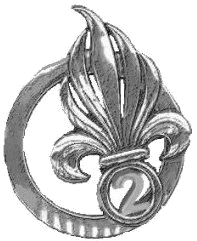
By Chris
Downes-Ward
- Index
-
- History
- Current
Status
- Organisation
- Regimental
HQ
- Cavalry
Squadrons
- Equipment
The 2e Régiment Étranger de Cavalerie has
to be one of the most often disbanded units in the Légion. It was first raised as part of
the expansion of the Légion in
July 1939. The regiment traces it's roots back to
Régiment Dauphin Étranger Cavalerie formed by Louis XIV
in the name of his son. It's contribution to World War II
was to remain in Algeria and be disbanded by the German
Armistice commission on 15th November 1940. The regiment
was re-raised on 26th April 1946 in order to provide
reinforcements for 1e REC in Indochina,
however it soon saw combat itself in Morocco.
The next major action for 2e REC was when
the 2e Escadron was detached to support 1e
REP for the Suez operation. During the Algerian conflict
2e REC took part in the battle of the
frontiers acting against ALN insurgents attempting to
enter Algeria from Tunisia. Later in the war 2e
REC operated in southern Algeria before being disbanded
again on 12th June 1962 at Biskra and absorbed into 1e
REC.
With the outbreak of the WWIII the Légion
expanded again and once more 2 REC came into existance,
this time it was equipped with obsolete armoured cars
manned by refugees, deserters and other people that
France would rather have die for her than making trouble.
The reformed regiment was sent to police the Dead Zone
along the Rhine Frontier.
The regiment was still in existance at the outbreak of
the Saudi War in 2010 as was swiftly shipped to the Gulf
to support the British, French, Bavarian, Japanese and
Egyptian forces fighting agains the Iranians.
After the Saudi War the regiment spent several years
moving around French possessions in Africa, performing
the kind of unromantic role where just the presence of a
unit of displined soldiers was all that was needed.
In 2030 Canton moved to occupy Indochina, 2e
REC was one of the units slated to be part of the French
response, and indeed staged to Thailand before the
Cantonese backed down.
The next 35 years saw the French peace being forged
and 2e REC were part of that process,
shuttling from one trouble spot to another, indeed the
outbreak of the Russo-Ukrainian war in 2065 found it in
Burkina-Faso watching the border of Berbera and dealing
with the frequent incursions from that chaotic state,
there, much to it's chagrin it remained. As more French
troops were sucked into the war the regiment's remit grew
to cover the whole of central Africa.
By 2082 the French peace looked secure and the Defence
budget did not. Once again 2e REC folded its
flags and disappeared from the Légion
roster. It did not reappear until the tensions
surrounding the Alpha Centauri War caused it's reform in
2162.
Until the outbreak of the Central Asian War (in 2282)
2e REC specialised in low key dispersed
operations with its squadrons operating independantly.
The squadrons mostly operated on Earth but one long stint
on Provence Nouveau and another on Beta Canum Veanticorum
added new variety to the places that a légionnaire
could serve.
In 2282 the Central Asian War exploded and for the
first time in ages 2e REC deployed as a
regiment. This time to the plains of central Asia. Soon
the regiment was joined by 1e REC and the
newly formed 3e REC as GMLE - Groupement
Mobile Légion Étrangère.
Although the steppes were well suited to 2e
REC's fast moving style the 5 years of warfare caused a
steady drain of casualties, especially in the later
phases of the war before the Japanese intervention. The
regiment was very heavily handled during the Battle of
Orsk even though it was one of the few units that
succesfully broke out of the Machurian encirclement. By
the time the war ended 2e REC was but a shadow
and badly in need of a long period of rest and
rebuilding.
The regiment was shipped to the colony world of Beta
Canum Venaticorum to rebuild and there it remained
restoring it's manpower, but defintely on the low
priority list for equipment.
The regiment was still on Beta Canum Venaticorum when
the war of German Reunification started in 2292 and there
it remained garrisoning the vital Beanstalk area and
patrolling the hinterland of the French continent. Plans
were drawn up to ship the regiment back to Earth to take
part in the defence of France but the armistice came
before the transports.
Five years later the regiment was shipped further up
French arm to Aurore just in time to meet the Kafer
onslaught, it has remained there to this day.
Below: 2e
REC Pocket Badge
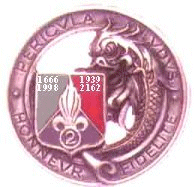

The 2e REC is stationed on Aurore where it
has taken part in much fighting against the Kafers along
the Ecumant river valley. The regiment has what is
considered to be second line equipment but due to the
distance from Earth and the pressure of the Kafer war it
has to make do.
The regiment operates over a large area and is
normally split into squadron sized task forces using hit
and run tactics against the Kafers. For these operations
the regiment is often reinforced by a Compagnie
d'artillerie equipped with VALR-12’s
and an Aero Scout platoon of 6 Guerrin-Rousette AG-7
Tilt-Rotor scouts attached to regimental headquarters.
Alternatively 2e REC can be concentrated to
spearhead larger attacks or to act as a Divisional
reserve or screening force. Occasionally the regiment
acts in squadron groups to provide and armoured punch to
infantry battalions.
Officially 1e Régiment Cavalrie
d’Aurore has the same organisation as 2e
REC, however its is seriously under strength and its 1e
and 3e Esqadrons have only one Aero Char and
one Aero Cavalrie troop and the 2e Escadron is
organised as a pure Aero Char Escadron of 3 troops each
of 3 German Mark IX Lukis.
The other Légion Étrangère cavalry
regiments are 1e REC on Tirane with the crack
2e Division Légère Blindée which is
equipped with modern ACL-7 medium hovertanks, and 3e
REC with the similarly equipped 1e Division
Légère Blindée on Earth.

The regiment consists of the Regimental
Headquarters and three Cavalry
Squadrdons.
All personel numbers given here a theoretical. If
practice, combat losses, illness, desertion, detachment
to junior leaders courses or any number of other causes
will result in units being below strength.
The regimental total is 24 officers, 82 NCO's and 324 légionnaires. This gives a total stength
of 430.
The regimental headquarters consists of Escadron de Commandement et des Services,
Section des Services and Section de la Réparation.
Subordinate to the Escadron de Commandement et des
Services are the Section des Services
and the Section de la Réparation.
The squadron has 5 officers, 8 NCO's and 25 légionnaires. Also part of the
headquarters is the Regimental Chaplain, the Chaplain is
assigned one of the ASL-12's and a légionnaire
as a Driver and bodyguard. The current Chaplain's driver
seems determined to compensate for the fact that the
Chaplain does not carry weapons and is known as 'The
Padre's Private Army' (L'Armée Privée De Padre). The
Chaplain is counted as one of the officers.
Including the Section des Services and Section de
Réparation there are 6 officers, 10 NCO's and 63 légionnaires in the Squadron.
The section has 1 Officer (the Medical Officer), 1 NCO
and 27 légionnaires of whom 5 are
trained medical attendants.
The Section has 1 NCO and 11 légionnaires,
3 of whom are trained mechanics.
Below:
Organisational diagram for 2e
REC
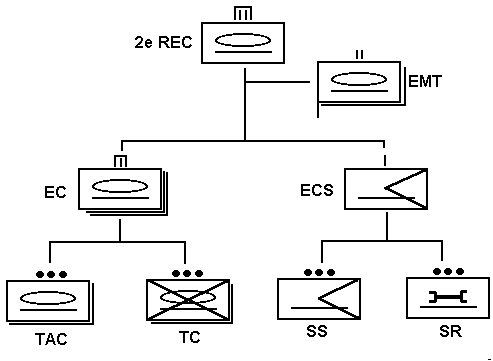
There are three numbered squadrons, 1e
Escadron, 2e Escadron and 3e
Escadron. Each squadron has a Troupe de
Commandement et des Services, 2 Troupe
Aéro Char and 2 Troupe Cavalrie.
In total there are 6 officers, 24 NCO's and 87 légionnaires in a Squadron.
The Troupe de Commandement et des Services often has a
forward observer attached from a supporting artillery
formation, these observers normally ride in an ACVI-3/VOA (Véhicule de Observateur d'
Artillerie). Subordinate to the Troupe de
Commandement et des Services are the Group
des Services and the Group de la
Réparation.
There are 2 Officers, 3 NCO's and 10 légionnaires
in the Troupe. Including the Groupe des Services and the
Groupe de Réparation there are 2 officers 6 NCO's and 25
légionnaires in the Troupe de
Commandement et des Services.
There are 2 NCO's and 6 légionnaires
in the Groupe, 2 of whom are trained as medical
assistants.
There is 1 NCO and 9 légionnaires
in the Groupe all of whom are trained in various
maintenance duties.
Below:
Organisational diagram for an Escadron de Cavalerie
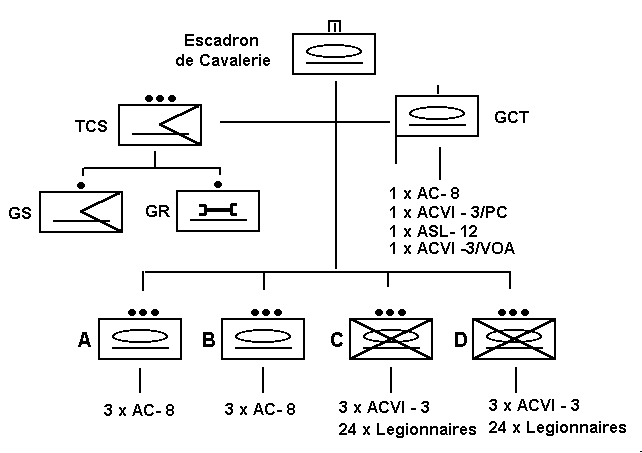
There are 2 hover tank troops,
designated A and B. each troop has 3 AC-8’s.
A troop has 1 officer, 2 NCO's and 6 other légionnaires for a total of 9 personnel.
There are 2 cavalry troops, designated C and D. Each
troop has 3 ACVI-3’s and 24
infantry. The infantry are organised as 3 x 6 man
dismounted squads and a 6 man troop headquarters. The
troop headquarters is distributed between the
ACVI-3’s. The infantry are equipped with
FAM-90’s with the designated sniper as part of the
troop headquarters been equipped with an FTE-10. Each
dismount squad consists of a 4-man fire team (with
FAM-90’s) and a 2-man support team with a
Quinn-Darlan Mk 2-A2 PGMP and one FAM-90.
The headquarters squad consists of the troop commander
(normally a Sous Lieutenant or a Lieutenant), the troop
sergeant, a communications specialist, a sniper and a 2
man team equipped with a Guiscard Martel light anti-air
missile. During operations against Kafers (who have
little air power) the Guiscard Martel team often carry a
Quinn-Darlan Mk 2-A2 PGMP instead.
All the troopers have ballistic fatigues and a
Cuirasse de Combat as well as a 2245 pattern helmet.
A troop has 1 officer, a troop sergant, 6 other NCO's
(3 normally command the ACVI-3’s) and 3 the dismount
squads), 6 other vehicle crew and 19 légionnaires
in the dismount sections. In total there is 1 office, 7
NCO's and 25 légionnaires for a
total of 33 personnel.
Below:
Organisational diagram for a Troupe de Cavalerie
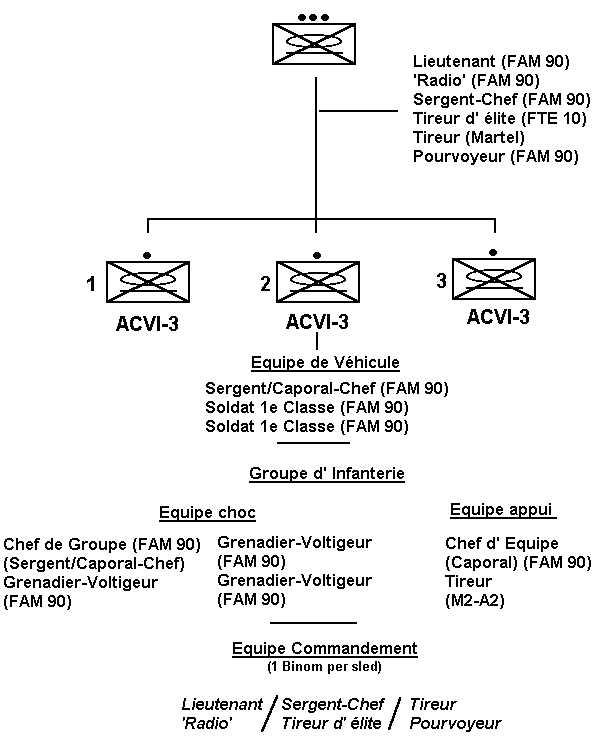

Now considered obsolete and replaced by the AC-12 the
AC-8 continues in service with colonial and second line
units on the grounds that 'it’s a tank and it’s
got a gun'. The AC-8 has a sponson mounted 8cm mass
driver and a turret mounting a 25mm auto cannon, 7.5mm
machine gun and a Guiscard Aero-12 missile launcher and 8
missiles.
It has a crew of 3, a driver, a commander and a
gunner.
Aéro Vehicle Combat D’Infanterie, 3 Ton
(ACVI-3)
Commonly know as the 'Bessieres' the regiment makes
use of 5 variants of this elderly ACV APC. Attached
forward observers often use the VOA
variant while attached artillery use the VALR-12.
This is the standard variant of the ACVI-3 used to
carry 8 infantry. It is armed with a Guiscard Aero-12
missile launcher and 6 missiles, a 25mm auto cannon and a
5.5mm machine-gun.
It has a crew of three, a driver, a commander and a
gunner. It can carry up to 8 passengers, or with 2000kg
of cargo.
This is a command post variant equiped with extra
communications equipment and an extendible shelter at the
rear. This variant retains the 25mm auto cannon and a
5.5mm machine-gun but discards the missiles to gain
space.
Some Poste Commandement versions have a small hangar
from which they can operate up to 4 'Minibee'
reconaisance drones.
It has a crew of three, a driver, a commander and a
gunner. It can carry up to 6 passengers, of whom 2 are
system operators.
An ambulance variant, this was greeted as an
improvement over the ACVI-2 Transporteur de Blessé
carrying as it does two stretcher cases and 4 walking
wounded, however it lacks facilities compared to the more
modern ACVI-4/Ambulance variant. This variant is normally
unarmed but as the Kafers have not heard of the Geneva
Convention a number of field expedient machine-gun mounts
have been introduced on Aurore.
It has a crew of three, a driver and 2 attendants.
A complement to the ACVI-3/PC this is a specialised
communication vehicle mounting a full ground to orbit
communications facility. This variant retains the 25mm
auto cannon and a 5.5mm machine-gun but discards the
missiles to gain space.
It has a crew of three, a driver, a commander and a
gunner. It can carry up to 4 system operators.
This is the light repair and recovery variant mounting
a crane, in place of the turret, rated to 8 tons when
stationary with the stabilising struts deployed. This
discards all armament and has a single 5.5mm pintel
mounted machine-gun.
It has a crew of 4, a driver and 3 support staff.
This is a specialised artillery observation variant
which has an enlarged turret mounting sighting devices
and a laser designator. It is armed with a Guiscard
Aero-12 missile launcher and 6 missiles, a 25mm auto
cannon and a 5.5mm machine-gun.
It has a crew of 5, a driver, a gunner, a commander,
an observer and a systems operator
This vehicle is identical to the standard ACVI-3
except that two eight-tube, box launchers for 12cm
rockets have replaced the armament.
It has a crew of 3, a driver, a commander and a
gunner.
In function, if not appearance, this is the French
version of the Bridgeport Swift Warbird, it is used for
general liaison duties and is occasionally pressed into
service for scouting roles. It has a single pintel mount
which normally carries some sort of machine gun although
some have been seen with a CLP-1A (Cannon Legere
Pyrotechnique-1A) mounted.
The ASL-12 has a driver and can carry up to 5
passengers.
This vehicle is a general utility hovercraft designed
to carry palletised loads of up to 2000Kg. It is also
used as the basis of a number of more specialised
vehicles such as the AEM-18. The ASM-2 is normally
unarmed but has a single pintel/ring mount above the cab.
The ASM-2 has a driver and can carry up to 2
passengers in the cab.
Essentially an ASM-2 with a workshop mounted on the
truck bed, the AEM-18 is used to provide local
engineering and maintenance facilities. The AEM-18 is
normally unarmed but has a single pintel/ring mount above
the cab.
The AEM-18 has a driver and can carry up to 4
passengers. These passengers are normally the workshop
staff.

|